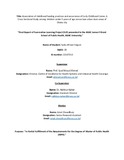Association of childhood feeding practices and occurrence of early childhood caries: A cross sectional study among children under 5 years of age across two urban slum areas of
Abstract
Introduction
Early Childhood Caries (ECC) is the occurrence of a carious lesion in a primary tooth in children
less than 71 months. It is a significant dental problem that has negative effects on the growth
and development of children affected. The objective of this study was to explore the association
between early childhood feeding practices and the occurrence of dental caries in children under
the age of 5 living in the selected slums of Dhaka city.
Method
ECC and risk factors were examined using data from 402 children (between ages of 6 months
and less than 5 years old) recruited via systematic random sampling and cross-sectional
explorative study design in Dhaka's Dholpur and Korail slums. The age, sex, socioeconomic
position, oral hygiene practices, childhood-feeding practices, mother’s knowledge of oral health,
and oral health seeking practices of children were collected from their mothers through a
guided questionnaire tool. In addition, the oral hygiene and caries status of children were
evaluated using the Decayed, missing, and filled teeth (DMFT) index. Using chi-square and
logistic regression analysis, risk variables related with ECC were identified.
Findings
Fifty-five children (14 %) children had ECC. There was association between ECC and the child's
age and consumption of sugary foods. Compared to 0-11-month-olds, 48-59-month-olds had 25
times more dental caries. Children who don't eat sugary foods are less likely to have dental
caries, while those who do are three times as likely.
Conclusion
ECC is low in the population under study, but increasing mothers' oral health knowledge may
lead to better oral hygiene behaviors and reduced sugary snack intake. It would be helpful to
undertake more study to evaluate ECC risk factors to recommend appropriate strategies based
on risk factors and dissemination of information / build awareness to reduce the occurrence.
Description
This project report is submitted in partial fulfillment of the requirements for the degree of Master of Public Health (MPH), 2023.Department
James P Grant School of Public Health, Brac UniversityType
Project reportRelated items
Showing items related by title, author, creator and subject.
-
Explaining equity gains in child survival in Bangladesh: scale, speed, and selectivity in health and development
Adams, Alayne M; Rabbani, Atonu; Ahmed, Shamim; Mahmood, Shehrin Shaila; Al-Sabir, Ahmed; Rashid, Sabina F; Evans, Timothy G (© 2013 The Lancet, 2013)By disaggregating gains in child health in Bangladesh over the past several decades, signifi cant improvements in gender and socioeconomic inequities have been revealed. With the use of a social determinants of health ... -
Exploring parental perception of play in socio-emotional development of 3-5 years old children
Hasan, Rahnuma Binte (BRAC University, 2024-10)This study investigates how patents view play and how it affects the socio-emotional development of children aged between 3-5 years. Eight parents participated in in-depth interviews for the study, which focused on their ... -
Evaluation of a mathematics program for preprimary children in rural Bangladesh
Opel, Aftab; Zaman, Syeda Sazia; Khanom, Ferdousi; Aboud, Frances E. (© 2012 Elsevier Ltd, 2012)A randomized evaluation of a 9-month comprehensive math program for preprimary Bangladeshi school children addressed skills such as numbers, measurement, shapes, patterns, and space. Nine schools were randomly selected for ...


